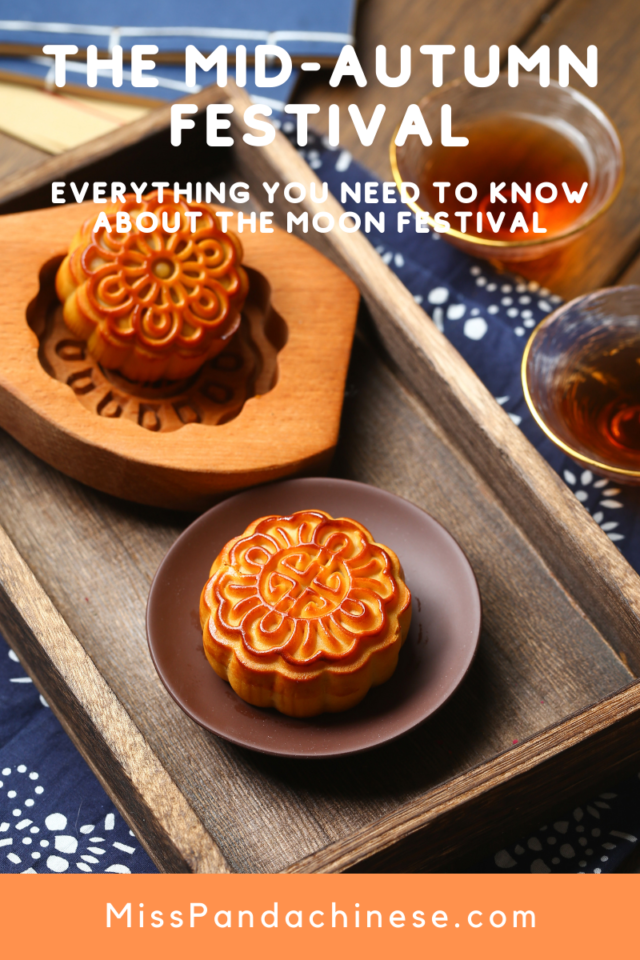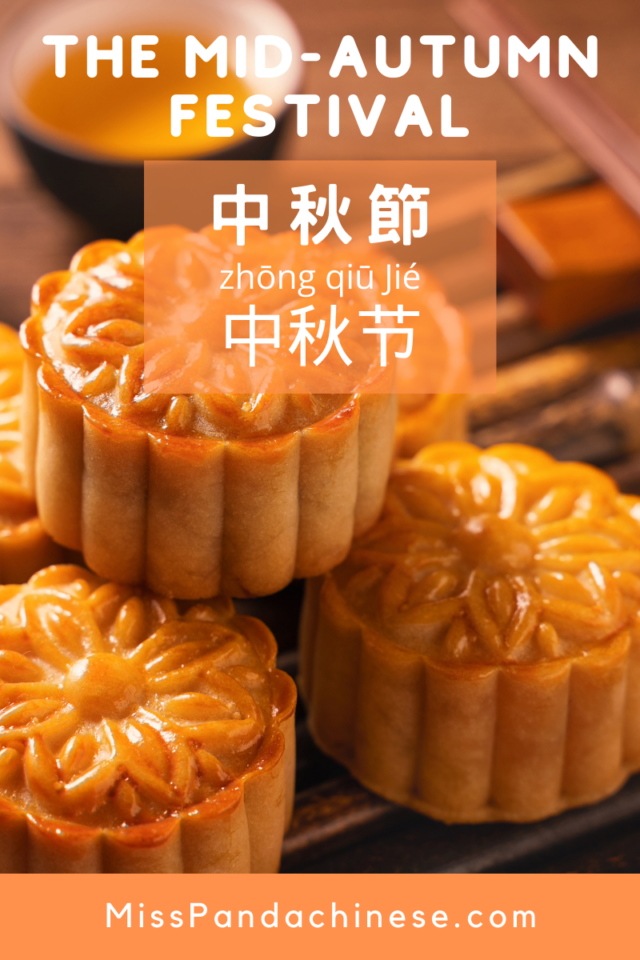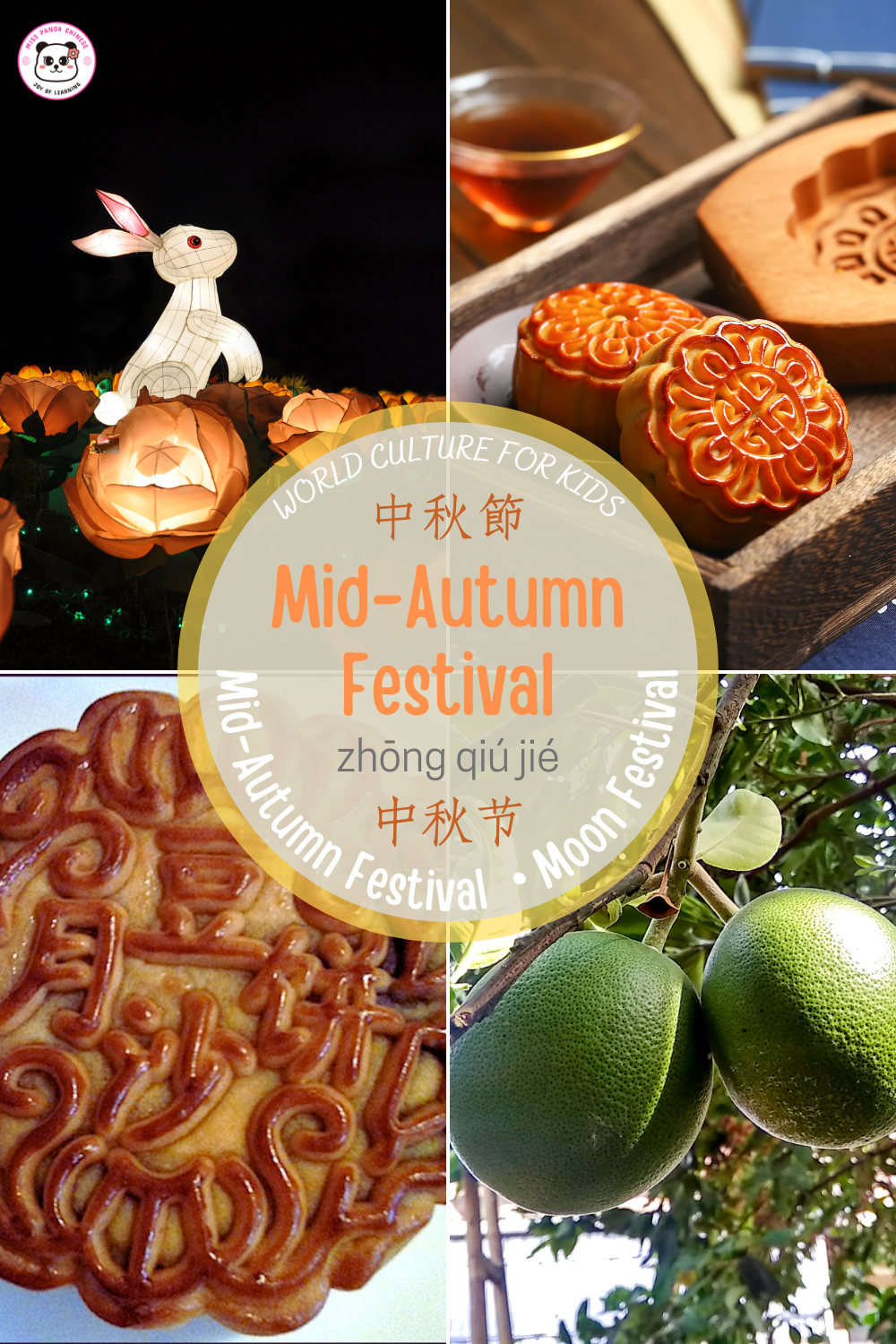The origin of the Mid-Autumn Festival
The Chinese Mid-Autumn Festival or “Zhōng Qiū Jié” (中秋節) occurs on the 15th day of the eighth lunar month each year (falling in September or October on our familiar solar calendar). Because this holiday is based on the lunar calendar, where it falls on the solar calendar varies from year to year.
As the festival is celebrated at the midpoint of the lunar month (also the middle of autumn), it is called the Mid-Autumn Festival = 中秋節 (traditional)= 中秋节(simplified) = Zhōng qiū jié (pinyin).
The Mid-Autumn Festival is also known as the “Moon Festival” as it is observed during a bright, full moon.
The story of the Mid-Autumn Festival
There are many folktales surrounding the Mid-Autumn Festival. Here is a popular version among Chinese children: A long time ago in China, there were ten suns in the sky. Because of this, it was very hot!
The blazing suns dried up the rivers and there was a serious drought. People were running out of water to drink and the crops in the rice fields were withering. A famous archer, Hòu yì, was summoned to shoot down 9 of the suns in the sky. He did it successfully and was rewarded a “pill of immortality.”
Hòu yì went home and gave the precious pill to his wife, Cháng’é, for safekeeping. A visitor of the archer’s, however, heard about this pill and wanted to steal it from his wife. As the visitor was about to steal the pill from her Cháng é swallowed it.
After she took the pill Cháng é felt lighter and lighter. Then she started to float. She flew all the way to the moon. When Cháng é got to the moon she coughed up the pill and the pill became a rabbit. The rabbit was the only companion Cháng é- the Moon Fairy- had on the moon and is named the “Jade Rabbit.”
Do you like the story? You can download this culture note and fun play pages in the Chinese Festivals: Moon Festival – Mid Autumn Festival Learning Unit printable set here!
When Chinese people talk about the “lady in the moon”, they are talking about Cháng é, = 嫦娥 = Cháng’é, the Moon Fairy.
Who’s who in the story
The famous archer – Hòu yì – 后羿
The moon fairy – Cháng é – 嫦娥
The jade rabbit – Yù tù – 玉兔
Photo credit: ©MissPandaChinese.com 2011-2018
Here come the Mooncakes
Mooncakes are out in the market weeks before the Mid-Autumn Festival. They are a seasonal gift among friends, family and business partners. Mooncakes are available at bakeries and restaurants. When you see the mooncakes for sale it is a sign that the Mid-Autumn Festival is coming.
There are various fillings in the mooncakes. The traditional ones have sweet fillings such as red bean paste, lotus seed paste, and Chinese date paste. You will also see the above flavors with one or two salty duck egg yolks inside. They are delicious but also high in calories.
With the current awareness of healthy eating, we now see smaller-sized mooncakes and low-calorie fillings of green tea, mochi, and even fruit.
Pick your favorite fillings for your mooncakes:
Red bean paste – Hóng dòu = 紅豆
Lotus seed paste – Lián zǐ = 蓮(莲)子
Chinese date paste – Zǎo ní = 棗(枣)泥
Egg yolk – Dàn huáng = 蛋黃
Make your Own Moon cakes at home with the mooncake mold.

Have you ever tried moon cakes? Here is A Guide to Mooncakes!
Let’s take a look at how moon cakes are made.
Recipes to try! Make your moon cakes!
Did you know there is a legend about the Chinese using mooncakes to deliver secret messages?
At one point the Chinese were ruled by the Mongolians and wanted to overthrow their foreign rulers. When the Mid-Autumn Festival came they inserted secret plans inside their mooncakes. When these mooncakes were delivered and eaten all the members who received the messages fought against the Mongolians according to the secret plan.
The Chinese successfully overthrew their Mongolian rulers and established the Ming dynasty (1368-1644 AD).
Family Tradition
A long time ago in China, fall was the season for harvest and, following that, the time for people working out of town to return home to be with their families. This tradition of traveling home to visit family remains to this day. Because of this, the Mid-Autumn Festival is thought of as a time for a family reunion.
Family members who work in different cities or provinces go home and enjoy an abundant family dinner. After the dinner families will have mooncakes and go outside to appreciate the moon in their yard or in the park.
This is also the time for the children to look at the moon and see if they can see the shadow of the Moon Fairy or the Jade rabbit. With the landing of the astronauts on the moon, we all know there is no moon fairy but the beautiful, enchanting story of the moon lady still has its charm in Chinese culture.
Pomelo Hats
Do you know pomelos are the seasonal fruit for the Mid-Autumn Festival? Some Chinese children put the peel of this large fruit on their head like a hat for fun.
Can you find pomelos and mooncakes in an Asian market near you? Why not check out the big moon tonight and see if you can find any interesting shadows? Happy Mid-Autumn Festival.
A Song to sing on the Moon Festival
月亮代表我的心 = Yuè liàng dài biǎo wǒ de xīn
月亮代表我的心 = Yuè liàng dài biǎo wǒ de xīn – The Moon Represents My Heart.
This song was recently performed by Bon Jon Jovi for Chinese Valentine’s Day. This song was originally performed by 鄧麗君[邓丽君]= Dèng lì jūn, Teresa Deng in Taiwan. This video has lyrics in Pinyin and simplified Chinese characters. My kids and students always have fun singing along with this video.
A Chinese Dish for Moon Festival: Chef Katie Chin and her master chef mother, Leeannㄡ
Katie and LeeAnn on the Today Show from Matthew Jonas on Vimeo.
Books to share on Moon Festival:
Miss Panda Chinese Fun Sheet Culture Series on TpT: Mid Autumn Moon Festival learning unit (FREE download)
Hands-on Activities for the Mid Autumn Festival Celebration
Make lanterns!
Draw A Good Luck Moon Rabbit with Author Grace Lin!
Related articles and teaching resources:
The Mid Autumn Festival Everything You Need To Know
Chinese Mid Autumn Festival The Folktale, A Story About The Moon and An Interview
Activity Resource For Home and In the Classroom:
-
Reading: The Mid Autumn Festival A Poem (Simplified Chinese-Pinyin-English with AUDIO support)
-
Reading: The Mid Autumn Festival A Poem (traditional Chinese-Pinyin-English with AUDIO support)
-
The Solar System Planets Basic Facts Posters (Simplified Chinese-Pinyin-English with AUDIO support)
-
The Solar System Planets Basic Facts Posters (traditional Chinese-Pinyin-English with AUDIO support)
-
Word Wall: The Solar System Planets Word Signs (traditional Chinese and Simplified Chinese-pinyin-English with AUDIO support)
Mid Autumn Festival tradition • Mid Autumn Festival tradition • Mid Autumn Festival tradition • Mid Autumn Festival tradition





What fantastic resources! Thank you for sharing such comprehensive information and teaching tools for Mid-Autumn Festival. 中秋节快乐!
Thank you for your kind words! Let’s always keep learning fun for kids and keep them engaged with the learning.
Oh awesome! I just learnt that song and am going to teach my daughter tomorrow. Love it!!! Thanks for the resources,
Enjoy and have a lot of fun singing with your little one!